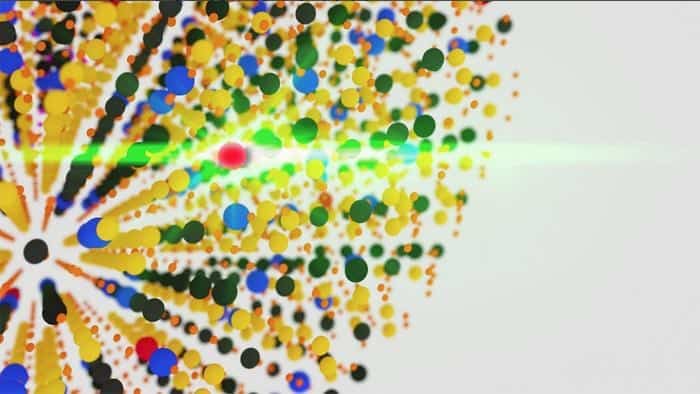Two independent teams in the US have demonstrated the potential of using the optical properties of nanocrystals to create remote sensors that measure tiny forces on tiny length scales. One team is based at Stanford University and used nanocrystals to measure the micronewton-scale forces exerted by a worm as it chewed bacteria. The other team is based at several institutes and used the photon avalanche effect in nanocrystals to measure sub-nanonewton to micronewton forces. The latter technique could potentially be used to study forces involved in processes such as stem cell differentiation.
Remote sensing of forces at small scales is challenging, especially inside living organisms. Optical tweezers cannot make remote measurements inside the body, while fluorophores – molecules that absorb and re-emit light – can measure forces in organisms, but have limited range, problematic stability or, in the case of quantum dots, toxicity. Nanocrystals with optical properties that change when subjected to external forces offer a way forward.
At Stanford, materials scientist Jennifer Dionne led a team that used nanocrystals doped with ytterbium and erbium. When two ytterbium atoms absorb near-infrared photons, they can then transfer energy to a nearby erbium atom. In this excited state, the erbium can either decay directly to its lowest energy state by emitting red light, or become excited to an even higher-energy state that decays by emitting green light. These processes are called upconversion.
Colour change
The ratio of green to red emission depends on the separation between the ytterbium and erbium atoms, and the separation between the erbium atoms – explains Dionne’s PhD student Jason Casar, who is lead author of a paper describing the Stanford research. Forces on the nanocrystal can change these separations and therefore affect that ratio.
The researchers encased their nanocrystals in polystyrene vessels approximately the size of a E coli bacterium. They then mixed the encased nanoparticles with E coli bacteria that were then fed to tiny nematode worms. To extract the nutrients, the worm’s pharynx needs to break open the bacterial cell wall. “The biological question we set out to answer is how much force is the bacterium generating to achieve that breakage?” explains Stanford’s Miriam Goodman.
The researchers shone near-infrared light on the worms, allowing them to monitor the flow of the nanocrystals. By measuring the colour of the emitted light when the particles reached the pharynx, they determined the force it exerted with micronewton-scale precision.
Meanwhile, a collaboration of scientists at Columbia University, Lawrence Berkeley National Laboratory and elsewhere has shown that a process called photon avalanche can be used to measure even smaller forces on nanocrystals. The team’s avalanching nanoparticles (ANPs) are sodium yttrium fluoride nanocrystals doped with thulium – and were discovered by the team in 2021.
The fun starts here
The sensing process uses a laser tuned off-resonance from any transition from the ground state of the ANP. “We’re bathing our particles in 1064 nm light,” explains James Schuck of Columbia University, whose group led the research. “If the intensity is low, that all just blows by. But if, for some reason, you do eventually get some absorption – maybe a non-resonant absorption in which you give up a few phonons…then the fun starts. Our laser is resonant with an excited state transition, so you can absorb another photon.”
This creates a doubly excited state that can decay radiatively directly to the ground state, producing an upconverted photon. Or, it energy can be transferred to a nearby thulium atom, which becomes resonant with the excited state transition and can excite more thulium atoms into resonance with the laser. “That’s the avalanche,” says Schuck; “We find on average you get 30 or 40 of these events – it’s analogous to a chain reaction in nuclear fission.”
Now, Schuck and colleagues have shown that the exact number of photons produced in each avalanche decreases when the nanoparticle experiences compressive force. One reason is that the phonon frequencies are raised as the lattice is compressed, making non-radiatively decay energetically more favourable.
The thulium-doped nanoparticles decay by emitting either red or near infrared photons. As the force increases, the red dims more quickly, causing a change in the colour of the emitted light. These effects allowed the researchers to measure forces from the sub-nanonewton to the micronewton range – at which point the light output from the nanoparticles became too low to detect.
Not just for forces
Schuck and colleagues are now seeking practical applications of their discovery, and not just for measuring forces.
“We’re discovering that this avalanching process is sensitive to a lot of things,” says Schuck. “If we put these particles in a cell and we’re trying to measure a cellular force gradient, but the cell also happened to change its temperature, that would also affect the brightness of our particles, and we would like to be able to differentiate between those things. We think we know how to do that.”
If the technique could be made to work in a living cell, it could be used to measure tiny forces such as those involved in the extra-cellular matrix that dictate stem cell differentiation.
Andries Meijerink of Utrecht University in the Netherlands believes both teams have done important work that is impressive in different ways. Schuck and colleagues for unveiling a fundamentally new force sensing technique and Dionne’s team for demonstrating a remarkable practical application.
However, Meijerink is sceptical that photon avalanching will be useful for sensing in the short term. “It’s a very intricate process,” he says, adding, “There’s a really tricky balance between this first absorption step, which has to be slow and weak, and this resonant absorption”. Nevertheless, he says that researchers are discovering other systems that can avalanche. “I’m convinced that many more systems will be found,” he says.
Both studies are described in Nature. Dionne and colleagues report their results here, and Schuck and colleagues here.


